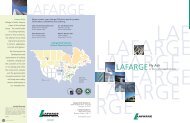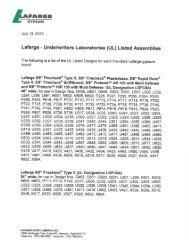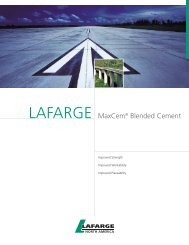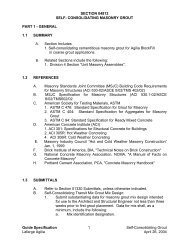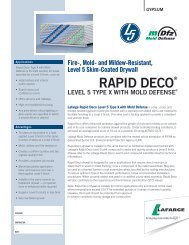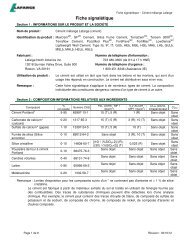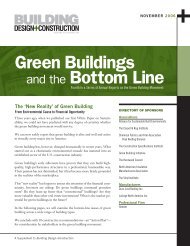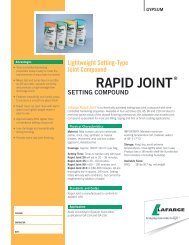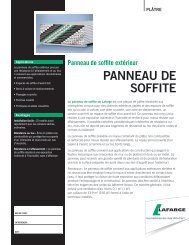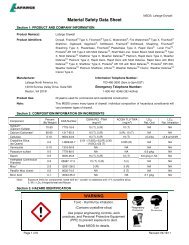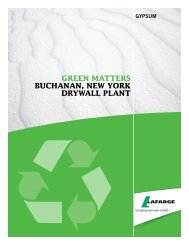LAFARGE
Fly Ash: Geotechnical Applications - Lafarge
Fly Ash: Geotechnical Applications - Lafarge
You also want an ePaper? Increase the reach of your titles
YUMPU automatically turns print PDFs into web optimized ePapers that Google loves.
<strong>LAFARGE</strong>Self-Cementing Fly Ashin Geotechnical Applications
Fly Ash A Solid IdeaLafarge A Solid Supplier!"Meet customer needs." It's such abusiness basic, yet so necessary forsuccess. This is why Lafarge is a reliablesource of supply. We've developed acompany-wide sourcing system thattransports product from areas withsurpluses to those in need. Lafargehas invested in over 225,000 tonsof ash storage, hundreds of rail cars,and dozens of pneumatic truck trailers.In addition to reliable product supply,our customers need reliable productperformance. To meet this need,Lafarge has established a rigorousquality assurance program, rigid productstandards, and an ongoing researchand development program that providescontinuous research studies and producttests at Lafarge laboratories in the U.S.,Canada and Europe.
What is Fly Ash?Fly ash is an extremely fine powderconsisting of spherical particles lessthan 50 microns in size. Fly ash is oneof the construction industry's mostcommonly used pozzolans. Pozzolansare siliceous or siliceous/aluminomaterials possessing the ability to formcementitious compounds when mixedwith lime [calcium hydroxide (CaOH)]and water.The word "pozzolan" is named afterthe small Italian town of Pozzuoli wheresome of the first hydraulic cementswere created over 2000 years ago.The ancient Romans used volcanic ashas a pozzolan in their structures, someof which still stand today.In North America over 26 million tonsof pozzolans are consumed each yearin concrete, concrete products, andgeotechnical applications.Self-Cementing Fly Ashin Geotechnical ApplicationsWhat is Self-Cementing Fly Ash?Self-cementing fly ash is a hydrauliccementitious material possessingpozzolanic properties and a highcalcium oxide content which allowsit to set and harden through chemicalinteraction with water. The chemicalreaction that occurs during the hydrationprocess of self-cementing fly ash issimilar to the hydration process ofportland cement.There are three separate chemicalreactions that take place when selfcementingfly ash is mixed with soiland water.The first is the reaction betweenthe tricalcium aluminate (C3A) andwater. This is the primary cementitiousreaction. The C3A is responsible forthe early strength gain and fast settingcharacteristics of the self-cementingfly ash soil mixture.The second reaction is the pozzolanicreaction. The silicates and aluminatesare oxides present in the self-cementingfly ash and in most soils, although notall soils contain these oxides. It shouldbe noted that lime stabilization dependson the silicates and aluminates presentin the soil, whereas the self-cementingfly ash will inherently contain theseoxides. The reaction of the pozzolanicoxides forms the basis for the long-termstrength gain in self-cementing fly ashstabilized soils.The third reaction which takes place inthe self-cementing fly ash soil mixtureis the carbonate reaction. This reactionis ineffective in terms of soil stabilizationand adds little strength.3
Where DoesFly Ash Come From?Fly ash is produced by coal-fired powerplants during the combustion of coal.Fly ash consists mainly of inorganicglassy particles formed from the mineralmatter in the coal. During combustion,these minerals are heated to a moltenstate and chemically combined andsolidified while suspended in theexhaust gas. They are then collectedby electrostatic precipitators orbag houses.Fly ash is classified based on thechemical and physical compositionof the ash.Self-cementing fly ash is normallyproduced from lignite or sub-bituminouscoal that meets the applicablerequirements.Fly Ash andthe EnvironmentUsing self-cementing fly ash reducesthe amount of by-product materialthat is landfilled, enables aggregatemanufacturers to minimize mining andprocessing virgin materials, and reducesthe export and import of materialsto the job site, thereby reducing theemission of carbon dioxide.Self-Cementing Fly Ashin Geotechnical ApplicationsApplicable StandardsAlthough ASTM C 618 StandardSpecification for Coal Ash and Rawor Calcined Natural Pozzolan for Useas a Mineral Admixture in Concreteis often referenced for use of fly ashin concrete, this standard should not bea requirement for use in geotechnicalapplications. The performance of thefly ash in geotechnical applicationsshould be confirmed usingASTM D 5239 Standard Practice forCharacterizing Fly Ash for Use in SoilStabilization.When fly ash is specified to mitigateshrink/swell properties of clay soils,procedures outlined in ASTM D 4829Standard Test Method for ExpansionIndex of Soils should be conducted toverify performance.Other applicable resources:ASTM E 1861 Guide for Use of CoalCombustion By-Products in Structural FillsFHWA-IF-03-019 Fly Ash Facts forHighway Engineers (revised June 2003)This brochure describes the advantagesof using self-cementing fly ash ingeotechnical applications and coversmany of the steps required to successfullyachieve desired results. Since in-situmaterials may vary from site to siteand even within a given project location,Lafarge recommends working witha local geotechnical firm to providetesting and establish propermix proportions.4
Self-Cementing Fly Ashfor Mitigating Shrink/Swell Propertiesin Expansive Clay SoilsApplicationsBasic UseSelf-cementing fly ash canbe successfully used forthe treatment of clay soilsto reduce their shrink/swellpotential. Self-cementingfly ash, when added to claysoil, cements the soil grainstogether and restricts theexpansion potential.In soils containing expansive clays,fluctuations in moisture content canchange the soil volume by as much as20 percent. If this volume change is notcontrolled, premature failure can occurto the overlaying structures.Typically, contractors utilize two solutionsto the expansive clay problem: replacethe clay with more stable fill or treatwith a lime-containing material. A thirdapproach uses self-cementing fly ashto stabilize clay soils by physicallybinding the soil particles together,restricting expansion and contractionof the clay soil.Other benefits include:1) increased strength, creating a morestable work platform and2) less sensitivity to additional moistureinfiltration, thereby reducing potentialdelays during the construction process.Self-cementing fly ash treatment ofclay soils is faster and generally moreeconomical than lime treatment.Hydrated lime [Ca(OH) 2 ] treatmentof soil is a chemical reaction whichagglomerates the clay particles. Limetreatment is usually a two-stage processwith a required mellowing period,ranging from 24 to 48 hours providingtime for the chemical reaction to occur.Self-cementing fly ash treatment is asingle stage process which greatly speedsconstruction. The effectiveness of limetreatment of clay soils is evaluatedby the determination of the clay'splasticity index. The plasticity indexis the subjective indicator of a soil'spotential to swell and not an absolutedetermination. Due to the cementationof the soil particles and the smallquantity of free lime available, thedetermination of the plasticity indexbefore and after self-cementing flyash treatment as a means of assessingtreatment effectiveness is not valid.To accurately evaluate a material'sinfluence on a plastic soil, an actualshrink/ swell measurement must bemade with an expansion test suchas ASTM D 4829.Mix proportions are first determinedwith job site materials in a geotechnicallaboratory. The section to be treatedshould be shaped to the correct grade.Self-cementing fly ash is then placedon the soil at the recommended mixdesign application rate. The proportionsare based on the dry weight of the soil.The self-cementing fly ash soil mixtureis then thoroughly mixed with wateradded to the specified moisturecontent. Final moisture content at thetime of compaction should not exceedthe specified moisture content.Additional self-cementing fly ash can beadded to lower the moisture contentto specified limits. Compaction shouldbegin immediately after mixing theself-cementing fly ash, soil and water.Final compaction should be completedwithin the compaction delay specifiedand to the specified density.The self-cementing fly ash soil mixtureshould be cured to protect againstrapid drying for at least three daysor until a pavement or slab is placedover the completed section. The soilcan be cured by either continuouslysprinkling with water or by coveringwith a two-inch layer of soil on thecompleted course.5
6Self-Cementing Fly Ashfor Hot Mix Asphalt (HMA)Pavement RecyclingBasic UseDeteriorated asphaltpavements can beeffectively and economicallyrehabilitated using selfcementingfly ash as astrength-enhancing agent.Existing HMA pavementis pulverized to create anew base course material.Self-cementing fly ash isadded to the pulverizedmaterials, providingadditional strength.The new, enhancedbase course is then pavedwith a new HMA wearingsurface. This process willprovide a high qualitypavement structurequickly and economically.Self-cementing fly ashstabilized bases demonstratestructural values over twicethat of natural crushedaggregate bases andprovide the added benefitof being open to trafficduring construction.ApplicationsThe use of self-cementing fly ashin recycled asphalt pavements is avery attractive alternative for statedepartments of transportation (DOTs),county engineers and commercialowners wanting to upgrade theperformance and durability of theirpavements and parking lots. Manycounties and most paving contractorshave pulvamixers and other equipmentrequired to complete HMA recyclingprojects.Asphalt pavement recycling generallyis either full depth recycling (FDR)where the existing HMA pavementand base course is pulverized toprovide a new base, or partial depthrecycling where the HMA is milled,enhanced and re-laid in place. Bothof these applications are commonlyreferred to as cold-in-place recycling(CIR). FDR is applied to rural highwaysthat are old, under-designed and whichare usually low volume roads withoccasional heavy loadings. Many FDRcandidate roads have deterioratedbeyond the point where maintenanceprocedures are effective.Full depth recycling consists ofpulverizing the existing HMA surfaceand most or all of the base courselayer, providing a uniform blend.This material is then compacted andgraded. Self-cementing fly ash isthen spread evenly over the pulverizedmaterial, pulverized again with theash to provide a homogeneous mixture,compacted with a vibratory pad-footroller, graded to final width and crossslope and compacted with a smoothdrum roller. As the self-cementingfly ash is being blended, water isinjected into the pulvamixer so thatthe predetermined densities andmoisture content are achieved.Both self-cementing fly ashconcentrations and moisture contentare pre-determined by lab testing.Frequently, this new base coursematerial is reopened to traffic beforethe new HMA wearing surface isconstructed.Some counties require that the newbase be left unpaved for up to threedays and kept moist-cured beforethe new HMA surface is applied.Occasionally, the design thicknessof the new HMA surface is reducedbecause the self-cementing flyash-enhanced, recycled base is somuch stronger.Partial depth asphalt recyclingapplications often require morespecialized equipment. The typesof roads conducive to this type ofapplication have high traffic andloading. These roads have typicallybeen engineered and constructed asopposed to having evolved over time.Because this type of recycling is fast,traffic can be returned quickly, makingthis application a good choice forcongested urban areas.As the name implies, the asphalt roadis recycled within the pavement layersand only removes the top several inches.Self-cementing fly ash is most oftenplaced directly in front of the millingmachine. Water is then added to themixture and, in some cases, retarderscan be added in hot weather conditionsto control the setting of the fly ash.The recycled asphalt pavement (RAP),self-cementing fly ash and water canbe screened and crushed if conditionswarrant. The self-cementing fly ash andRAP mixture is typically placed with aconventional asphalt lay-down machineand quickly compacted. The materialshould be sealed to allow the mixtureto cure and reach maximum strength.This recycled material is now ready forthe new HMA wearing surface. As witha full depth recycling technique, trafficcan quickly resume on the new baseuntil the wearing surface is applied.
Self-Cementing Fly Ashfor Structural FillApplicationsApplicationsBasic UseSelf-cementing fly ash is aneffective and economicalmaterial for the constructionof engineered structuralfill projects, building sitesand foundations, leveesand dikes, embankmentsfor highways, railroadsand other public worksrequiring a compactedfill material.The use of coal combustion products(CCPs), such as self-cementing fly ashand bottom ashes, for structural fillsis becoming more prevalent due to thedecreased supply and increased costof virgin fill materials. Transportationof these materials to a remote projectlocation can be very costly. CCPsprovide a self-supporting stabilizedback fill, which remains stable anddurable over time. Because CCPstructural fills have higher densitiesthey are often less susceptible to waterinfiltration than native soil or rock fills.Site construction procedures generallyproceed in a manner similar to claystructural fill projects with a fewexceptions related to the chemicaland physical nature of CCPs.The site should be grubbed ofvegetation and stripped of all topsoil.Provisions should be made for surfacedrainage control, particularly during theCCP placement process. Clay underliningand/or subsurface drainage provisionsshould be installed, if deemed necessaryby the engineer. Self-cementing flyash, which is naturally a dry powder,must be moisture conditioned into asoil-like consistency. Such processingcan occur at the source (the generatingstation), or at a separate facilitylocated at or near the construction site.Most bottom ashes are produced in aconsistency acceptable for use withoutadditional processing.Delivered in standard end dumps,CCPs are spread and placed using abulldozer that may (but not necessarily)be equipped with a spreader box.On small projects, placement can beaccomplished with a motor grader.CCPs should be placed in 8- to 10-inch(loose) lifts and compacted to specifiedstandards using a vibratory steel wheelroller. Compaction should occur quicklyfollowing placement to limit moistureloss and to ensure proper consolidationprior to initiation of the strength-gainprocess. Filling should proceed in liftsuntil the design elevations are achieved.CCP in-place densities should becertified at regular intervals to ensurethe structural integrity of the project.Measurements are generally completedusing nuclear density testing equipment.Facility construction may proceedimmediately following the completionof placement operations. Buildingfoundations, necessary undergroundfacilities, pavements, etc., may beconstructed directly above or withinthe CCP structural fill. Project sectionslocated outside of the facility footprintshould be covered with clay and/orother suitable soils for the purposeof sustaining vegetative growth andlimiting vertical surface water migration.Membrane capping materials andgeotextiles may also be used inthese areas.7
Self-Cementing Fly Ashfor Stabilizing Aggregate BasesBasic UseStabilized aggregate basescan be constructed usingself-cementing fly ash asthe cementing agent.ApplicationsThe stabilization of aggregate baseshas many benefits. The supply ofhigh-quality aggregates for road baseconstruction continues to diminish inmany communities, while new reservesare increasingly more difficult to permitdue to zoning and environmentalregulations. Sometimes qualityaggregates have to be transported longdistances, resulting in high constructioncosts. Using self-cementing fly ash tostabilize poor quality aggregates is oftena cost-effective solution. The cementingof the aggregate particles increasesboth the durability and strength ofthe aggregate base.With the advent of in-place methodsof stabilizing aggregates, high volumesof base material can be stabilizedwithout the expense of batch plants,transportation and pug mill operations.Also, the workability issues associatedwith the use of a pug mill withself-cementing fly ash is not a concernwith in-place methods. Additionally,the strength of the self-cementing flyash aggregate mixture is improved byeliminating delivery time of materialsfrom the pug mill operation to the siteof placement. The aggregate mix designproportions and compaction delay timeare established in the laboratory priorto commencement of construction.The correct quantity of self-cementingfly ash is then placed over the aggregate.The self-cementing fly ash aggregatemixture is then thoroughly mixed aswater is introduced to the process.The water can be introduced eitherjust prior to mixing or more preferably,injected into the pulvamixer as theaggregate and self-cementing flyash are being mixed. The stabilizedaggregate is then ready to be compactedand shaped to final grade.Compaction immediately followingmixing operations is imperative due tothe reaction time of self-cementing flyash. Shorter compaction delay timesprovide higher compressive strengths.8
Self-Cementing Fly Ashfor Soil StabilizationApplicationsBasic UseSelf-cementing fly ashhas been used effectivelyfor increasing the subgradesupport capacity ofpavements and forincreasing the shearstrengths of soils inembankment sections.In addition to providingadditional subgradesupport, the self-cementingfly ash stabilized areaprovides a more stablesection for pavingoperations and reducesthe potential for disturbancedue to construction trafficand adverse weather.Self-cementing fly ash has been usedfor over 20 years for the stabilizationof soils. Because self-cementing fly ashis cementitious, it can be used in manysoil stabilization applications as a standalone material.The mix proportions for a soilstabilization project are first determinedin the laboratory with job site materials.Lab testing includes proctor testingfor optimum strength and moisturecontent. The field section to be treatedshould be shaped to the correct grade.Based on the dry weight of the soil,self-cementing fly ash is applied at therecommended mix design applicationrate. The self-cementing fly ash soilmixture is then thoroughly mixed withwater added to the specified moisturecontent. Final moisture content at timeof compaction should not exceed thespecified moisture content. If too muchwater is added, additional self-cementingfly ash should be added to lowerthe moisture content to that whichis specified. Compaction should beginimmediately after the self-cementingfly ash, soil and water are mixed. Finalcompaction should be completed withinthe compaction delay specified andto the specified density. Delays incompaction will result in lower strengthsof the stabilized materials.The self-cementing fly ash soil mixtureshould be cured to protect againstrapid drying for at least three daysor until a pavement or slab is placedover the completed sections. The soilcan be cured by either continuoussprinkling with water or by coveringwith a two-inch layer of soil on thecompleted course.9
Self-Cementing Fly Ashfor Soil DryingBasic UseSelf-cementing fly ash hasbeen found to be a veryeffective drying agent,capable of reducing soilmoisture content by 30percent or more within amatter of hours. Dryingsoils is faster and lessexpensive than replacingwith dry soil, aggregates orother materials. Since thedrying effect is immediateand the soil is maderesistant to furthermoisture infiltration,self-cementing fly ashcan be of great benefitto owners and contractorswhen constructionschedules requireimmediate, unimpededconstruction.ApplicationsThe use of self-cementing fly ash todry soils is an economical alternative totraditional methods. Structures must beconstructed on stable soils. For a soil tobe stable it must be compacted to itsmaximum practical density. Becauseof the relationship between a soil'sdensity and water content, themoisture content of the soil must betightly controlled. If a soil is on the dryside of optimum for maximum density,the solution is simple. The contractorsimply adds water until the soil'smoisture content is close to optimum,usually specified to be 95% ofmaximum. But if a soil is too wet formaximum compaction, the soil mustbe dried or replaced with alternatematerials.A contractor and owner have severaloptions. One option is to remove andreplace the soil with a more suitablematerial. This is usually an expensiveoption given the cost of removing andreplacing the soil assuming a suitablesoil is locally available. Another optionis to wait for the weather to dry thesoil. The soil can be manipulated oraerated to speed the drying process.The disadvantage is the possibility thatadditional precipitation can furtherdelay the project. Another option isto add stone to the soil in an attemptto build a working platform. If thesite receives more precipitation, morestone must be added.Self-cementing fly ash is an optionfor drying soils which presents severalinherent benefits, such as creating amore stable work platform, reducingjob site dusting from constructiontraffic, adding strength to an existingsoil, and making the soil more resistantto further moisture infiltration. Ifself-cementing fly ash is used to dry asite, the stabilized soil tends to shedwater from the surface, not allowingthe water to penetrate. Therefore,as soon as the surface becomes dry,construction can proceed. When selfcementingfly ash is used to dry a site,typically a contractor familiar with localconditions simply calculates a reasonableapplication rate and then begins tomanipulate the self-cementing fly ashinto the soil until the proper moisturecontent is reached.10
Company ProfileLafarge North Americais part of the LafargeGroup. The world leaderin building materials,active on five continents,the Lafarge Group holdstop-ranking positions inall four of its divisions –cement, aggregatesand concrete, roofingand gypsum.Please contact your Lafarge Office for specific productinformation, availability and ordering.Lakes and Seaway Business UnitBingham Farms, MichiganPhone: 248-594-1991River Business UnitLee’s Summit, MissouriPhone: 816-251-2100U.S. East Business UnitAlpharetta, GeorgiaPhone: 678-746-2000Western Business UnitCalgary, AlbertaPhone: 403-271-9110Lafarge North AmericaCement Operating AreasBy focusing on thedevelopment andCalgary, ABimprovement of buildingmaterials, Lafarge putsthe customer at the coreof its strategy and offersthe construction industryand the general publicinnovative solutions thatwill bring more safety,comfort and beauty toour everyday lives.Business Unit OfficeLee’s Summit, MOBingham Farms, MIAlpharetta, GABusiness UnitsLakes and SeawayWesternRiverU.S. EastLimited WarrantyLafarge warrants that Lafarge Self-CementingFly Ash meets applicable ASTM and CSArequirements. Lafarge makes no other warranty,whether of merchantability or fitness for a particularpurpose with respect to this product. Having nocontrol over its use, Lafarge will not guaranteefinished work in which this product is used.PBSCFAC 1/07Printed on recycled paperCEMENTLafarge North America Inc.12950 Worldgate Drive, Suite 500Herndon, VA 20170Lafarge Canada Inc.606 Cathcart StreetMontréal, Québec H3B 1L7www.lafarge-na.com



